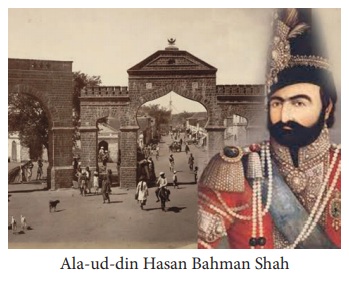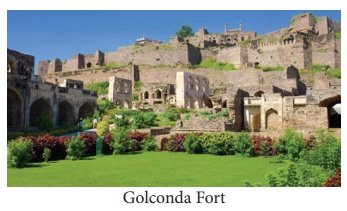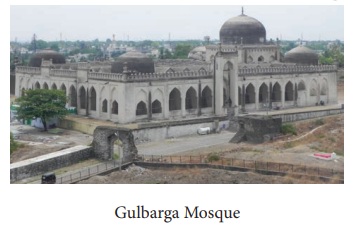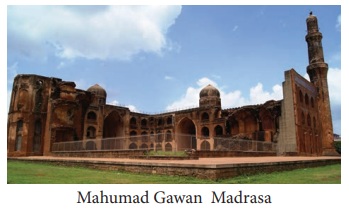Term 2 Unit 1 | History | 7th Social Science - Bahmani Kingdom | 7th Social Science : History : Term 2 Unit 1 : Vijayanagar and Bahmani Kingdoms
Chapter: 7th Social Science : History : Term 2 Unit 1 : Vijayanagar and Bahmani Kingdoms
Bahmani Kingdom
Bahmani Kingdom
Foundation and Consolidation
of the Bahmani Kingdom
Ala-ud-din Hasan, also known as Hasan
Gangu, seized Daulatabad and declared himself sultan under the title of Bahman Shah
in 1347. In his effort, this Turkish officer of Daulatabad (Devagiri) was supported
by other military leaders in rebellion against the sultan of Delhi, Muhammad bin
Tughluq. In two
years, Ala-ud-din Hasan
Bahman Shah shifted
his capital to
Gulbarga. His successors
found it difficult
to organise a stable kingdom even around Gulbarga. So
the capital was
again shifted to
Bidar in 1429.
There were 18
monarchs of the Bahmani
dynasty.

Ala-ud-din Hasan Bahman Shah (1347–1358)
Ala-ud-din
Hasan ruled for 11 years. His
attempt to exact
an annual tribute
from the state
of Warangal, the
Reddi kingdoms of
Rajahmundry and Kondavidu,
led to frequent
wars. Ala-ud-din Bahman
Shah divided the kingdom into four territorial divisions
called tarafs. A governor was appointed for each province. He commanded
an army, was solely responsible for its administration and for the collection of
the revenue. The system worked well under a powerful king, but its dangers became
apparent during the reign of a weak ruler.

Muhammad Shah I (1358–1375)
Muhammad shah I succeeded Bahman Shah.
He waged two wars with Vijayanagar but couldn’t gain from it. But his attack on
Warangal in 1363 earned him a large property and wealth, including the important
fortress of Golconda and his treasured turquoise throne, which thereafter became
the throne of the Bahmani kings.
Turquoise is a semi-precious stone sky blue in colour. Turquoise
throne is one of the bejewelled royal seats of Persian kings described in Firdausi’s
Shah Nama.
Muhammad Shah laid a solid foundation
for the kingdom. His system of government continued even after the Bahmani kingdom
disintegrated into five sultanates. He built two mosques at Gulbarga. One, the great mosque,
completed in 1367, measures 216 by 16 feet and has a roofed courtyard. A large number
of Arabs, Turks and notably Persians began to immigrate to the Deccan, many of them
at the invitation of Sultan Muhammad I and there they had a strong influence on
the development of Muslim culture during subsequent generations.

The Golconda Fort is located about 11 kilometres from Hyderabad on
a hill 120 meters height. The fort is popular for its acoustic architecture. The
highest point of the fort is Bala Hissar. It is believed that there is a secret
underground tunnel, which leads from the Durbar Hall to one of the palaces at the
foot of the hills.

Successors of Muhammad
Shah I
Mujahid, the son of Muhammad shah, ascended
the throne. However, on his returnto Gulbarga from the expedition against Vijayanagar,
he was assassinated and the nephew of the conspirator, Daud, the uncle of Muhammad,
was enthroned in 1378 as Muhammad II. Muhammad II’s reign was peaceful, and the
sultan spent much of his time building his court as a centre of culture and learning.
There were constant wars between the
Bahmani and Vijayanagar rulers over the fertile Tungabhadra–Krishna region. The
threat also came from the north, especially from Malwa and Gujarat. The noteworthy
ruler after eight and a half decades (1377 to 1463) was Muhammad (1463–1482). Muhammad III reigned for
19 years. For most of these years, the lieutenant of the kingdom was Mahmud Gawan,
the most notable personality of the time.
Eight ministers of the
Bahmani state:
1. Vakil-us-saltana or lieutenant of the kingdom, who was the immediate
subordinate authority of the sovereign. 2. Peshwa who was associated with the lieutenant
of the kingdom; 3. Waziri-kull who supervised the work of all other ministers; 4.
Amir-i-jumla, minister of finance; 5. Nazir, assistant minister for finance; 6.
Wasir-i-ashraf, minister of foreign affairs; 7. Kotwal or chief of police and city
magistrate in the capital; and 8. Sadr-i-jahan or chief justice and minister of
religious affairs and endowments.
Mahmud Gawan
A Persian by birth, Mahmud Gawan was
well-versed in Islamic theory, Persian and Mathematics. He was also a poet and a
prose writer. The Bahmani king Ala-ud-din Hasan Bahman Shah greatly impressed by
his wisdom and military genius, recruited him. He served with great distinction
as the Prime Minister under Muhammad III and contributed extensively to the development
of the Bahmani kingdom.
Gawan was known for his military campaigns
as well as administrative reforms. He used Persian chemists to teach the Bahmani
army about the preparation and the use of gunpowder. In his war against the Vijayanagar
kings in Belgaum, he used gunpowder. In order to tighten the administration and
to curb the power of provincial governors, who often functioned as virtual kings,
Gawan d ivided the existingfour provinces of the Bahmani Sultanate into eight provinces
so as to limit the area under the rule of each governor and to make the provincial
administration more manageable.
He also placed some districts in the
provinces directly under the central administration. Gawan sought to curtail the
military powers of the governors by allowing them to occupy only one fort in their
territory. The sultan kept the other forts under his direct control. The royal officers
who were given land assignments as pay were made accountable to the sultan for their
income and expenditure.
The administrative reforms introduced
by Gawan improved the efficiency of the government, but curtailed the powers of
the provincial chiefs, who were mostly Deccanis. So the already existing
rivalry among nobles such as Deccanis and Pradesis (foreigners) further intensified
and conflicts broke out. Gawan became a victim of this tussle for power. The Deccani
nobles grew jealous of his success and considered him as an obstacle to their rise.
They manipulated by forging a letter to implicate Gawan in a conspiracy against
the sultan. Sultan, who himself was not happy with Gawan’s dominance, ordered his
execution.
Decline of Bahmani Kingdom
Gawan’s execution prompted several of
the foreign nobles who were considered the backbone of the state to leave for their
provinces. After Sultan Muhammad III’s death, Mahmud or Shihab-ud-din Mahmud reigned
as the sultan until his death in 1518. His long rule is noted for the beginnings
of the process of disintegration. After him, four of his successors on the throne
were kings only in name. During this period, the Sultanate gradually broke up into
five independent Deccan kingdoms: Bidar, Bijapur, Ahmednagar, Berar and Golconda.
Contribution of Bahmani
Sultans
Architecture
The contribution of Bahmani kings to
architecture is evident in Gulbarga. Archaeological excavations done in the site
of the
kingdom has helped to unearth palaces,
halls of public audience, ambassadors’ residences, arches, domes, walls and citadels.
These finds are illustrative of their architectural skill.
Education
The founder of the Bahmani kingdom Ala-ud-din
Hasan Shah was educated at Multan at the initiative of Zabar Khan, a general of
Ala-ud-din Khalji. On his accession, he took specialcare in founding a school to
educate his sons. His son Muhammad I was a patron of learning. He opened institutions
for the purpose of educating the children of noble families in the art of soldiery.
Sultan Firoz, the eighth Bahmani king was a linguist and a poet. Later his successors
founded schools in Gulbarga, Bidar, Daulatabad and Kandahar. Boarding and lodging
at the king’s expenses were provided in these schools. Mahmud Gawan’s world famous
madrasa in Bidar, with a large library, containing a collection of 3000 manuscripts,
is illustrative of the importance given to scholarship and education by Gawan.

Summary
1.
The foundation of Vijayanagar kingdom by two brothers Harihara and Bukka and its
consolidation by their successors notably Devaraya II are described.
2.
The most illustrious ruler Krishnadeva Raya’s career and achievements are highlighted.
3.
Defeat of Vijayanagar at the hands of combined forces of Deccan Sultanates is narrated.
4.
Vijayanagar’s system of governance and economy are explored.
5.
Contributions of Vijayanagar to literature, art and architecture are also dealt
with.
6. Establishment of Bahmani kingdom by
Ala-ud-din Hasan Bahman Shah and its consolidation by his able successor Muhammad
I are detailed.
7. The administrative system introduced
by Bahman Shah and measures adopted by Muhammad I and later by Mahmud Gawan during
the kingship of Muhammad III are analysed.
8. Bahmani kings’ contribution to architecture
and education are also examined.
Glossary
1. conflict: a serious
disagreement முரண்பாடு / மோதல்
2. ascending: leading
upwards ஏறுவரிசையில்
3. subsequently: after a
particular thing நிகழ்ச்சிக்குப்பிறகு
4. adorned: decorated
அலங்ரிக்கப்பட்ட
5. pillaging: robbing,
using violence, especially in wartime ககபாள்ளையடிப்பு
6. intrigue: conspire,
plot சதிதிட்டம் / சூழ்ச்சி
7. primogeniture: the
right of succession belonging to the first child முதல் குழந்தக்கு வாரிசுரிமை
8. splendor: magnificent
கம்பீரம் /சிறப்புவாய்நத
9. flourishing: growing
successfully செழிக்கும்
10. prominence: the state
of being important முக்கியத்துவம்
11. indemnity: guarantee,
surety உத்திரவாம்
References
1.
J.L. Mehta, Advanced Study in the history of Medieval India: Mughal Empire,
Vol. II, 1526-17 07, Sterling Publishers, 2011.
2.
Burton Stein, Vijayanagara, The New Cambridge History of India, 1989.
3.
Abraham Eraly, The Emperors of Peacock Throne, Penguin, 2007.
Related Topics